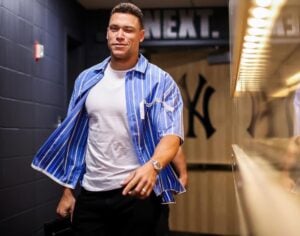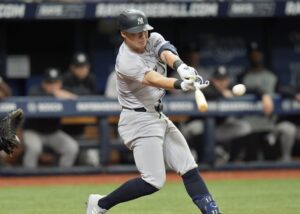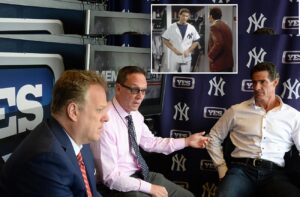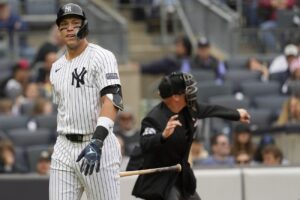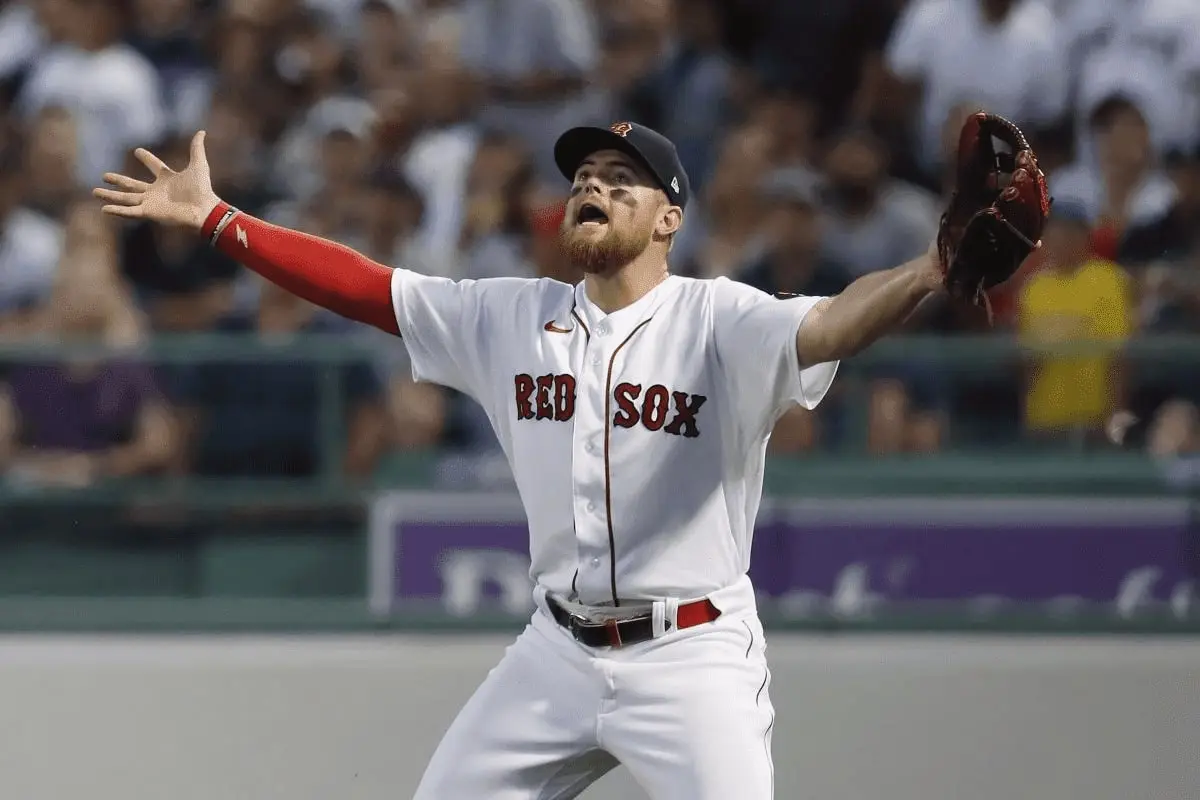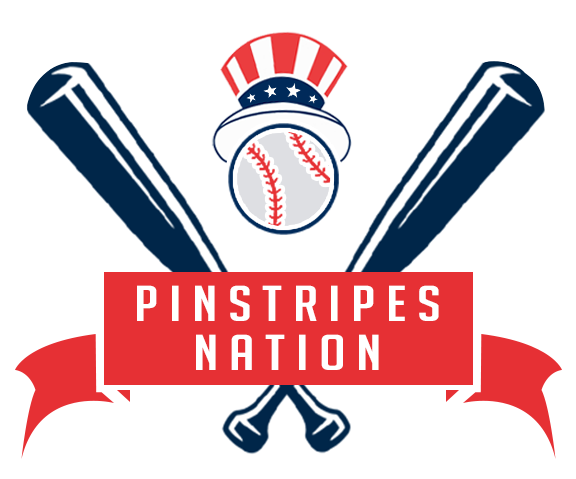Paul O’Neill: The Yankees’ warrior
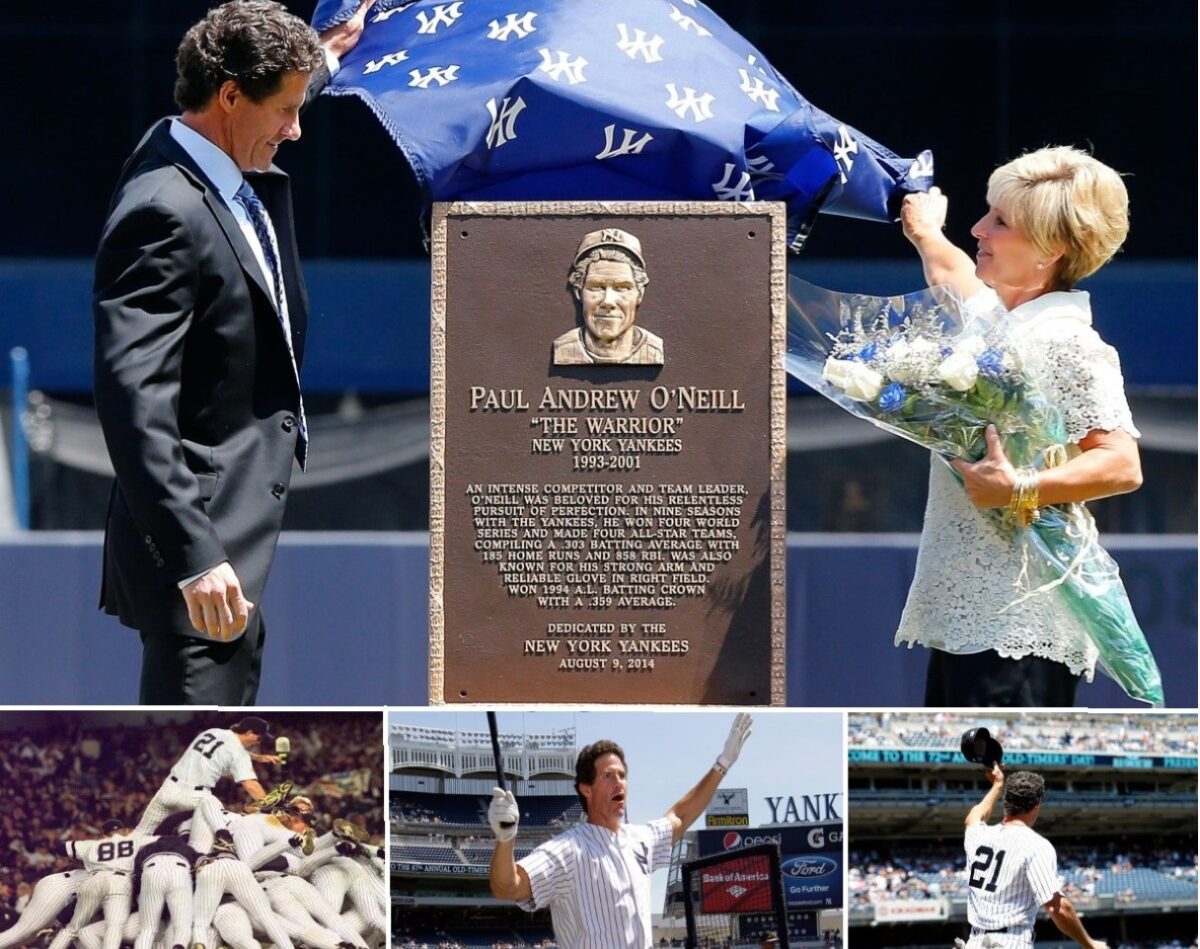
-
 Michael Bennington
Michael Bennington
- January 2, 2024
- 11:25 am
- No Comments
Table of Contents
| Position | October 7, 2001, New York Yankees vs. TBD |
| Active years | 1985 – 2001 |
| Teams (years) | Cincinnati Reds (1985–1992) New York Yankees (1993–2001) |
| Draft | September 3, 1985 |
| Debut | September 3, 1985 Cincinnati Reds vs. St. Louis Cardinals |
| Last game | October 7, 2001 New York Yankees vs. TBD |
| Date of Birth | February 25, 1963 |
| Native place | Columbus |
| Batted | Left |
| Threw | Left |
| All-Star | 5× All-Star (1991, 1994, 1995, 1997, 1998) |
| World Champions | 5× World Series champion (1990, 1996, 1998–2000) |
| AL MVP | |
| Shirt retired | New York Yankees No. 21 |
| Hall of Fame year | No |
| MLB Awards | AL batting champion (1994) |
| Legacy | Monument Park honoree |
| Nickname | The Warrior |
Yankee enthusiasts hold a special place in their hearts for Paul O’Neill, affectionately recognized as the “heart and soul” of the team’s 1990s dynasty. George Steinbrenner, the iconic Yankees owner, dubbed him “The Warrior” due to his profound passion and devotion to the game.
Over his 17-season MLB career, Paul O’Neill showcased his prowess with stints at the Cincinnati Reds (1985–1992) and the New York Yankees (1993–2001). His impressive stats include 281 home runs, 1,269 RBIs, 2,107 hits, and a lifetime batting average of .288. In 1994, he clinched the American League batting title with an outstanding .359 average. Boasting five World Series championships and five All-Star appearances (1991, 1994, 1995, 1997, and 1998), Paul O’Neill left an indelible mark on the baseball scene.
Notably, Paul O’Neill stands as the sole player to contribute to three perfect game victories. He patrolled right field during Tom Browning’s perfect game for the Reds in 1988, caught the decisive out in David Wells‘ perfect game for the Yankees in 1998, and played a pivotal role in securing victory during David Cone‘s perfect game in 1999 with a spectacular diving catch and a crucial double.
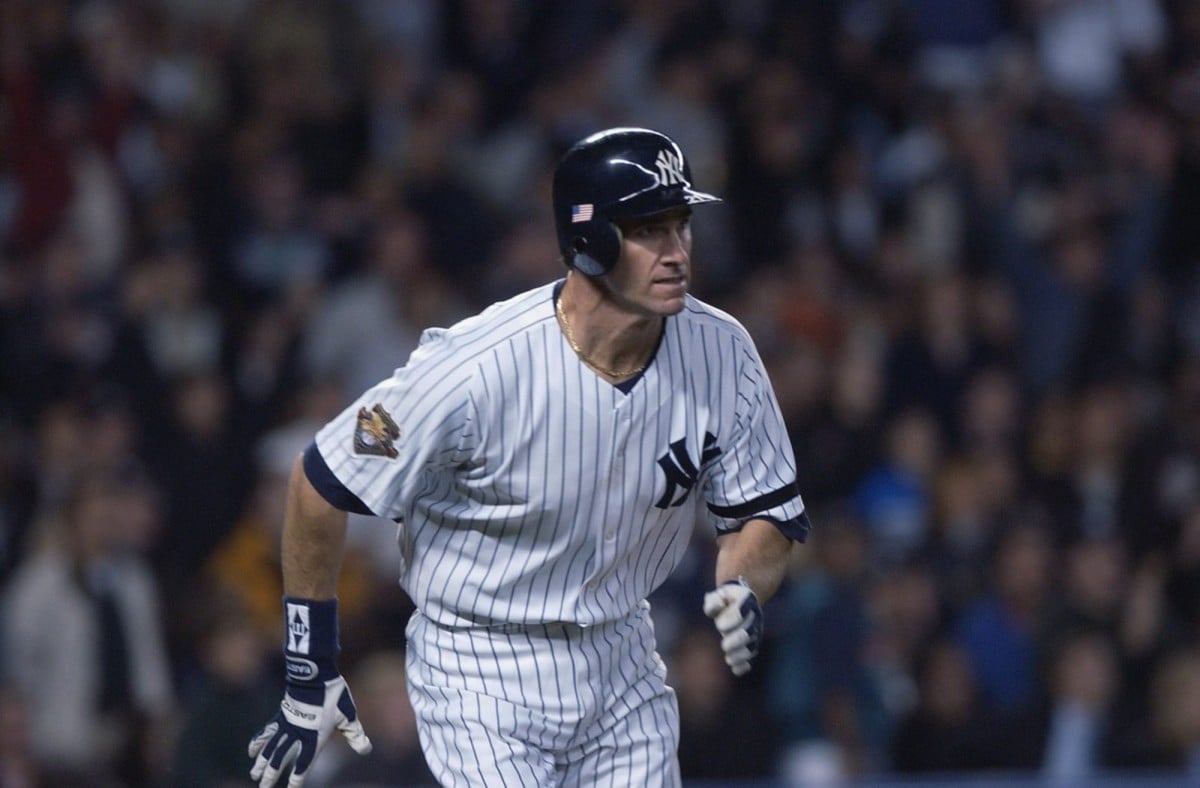
Early life and career
Paul Andrew O’Neill entered the world in Columbus, Ohio, on February 25, 1963, as the youngest among six siblings. His father, Charles ‘Chick’ O’Neill, managed his own excavation business but harbored a deep passion for baseball. A former minor league pitcher with a family history in professional baseball, “Chick” imparted his knowledge and love for the sport to all six of his children.
At the age of five, the O’Neill family moved to a larger house with a sprawling, grass-covered backyard, serving as an ideal makeshift baseball field for countless pickup games and home run contests. Growing up in Ohio during the 1960s and early ’70s, Paul O’Neill naturally became a fan of the Cincinnati Reds, attending his first major league game with his father at Cincinnati’s Crosley Field in the summer of 1970.
Chick not only coached Paul and his brothers in Little League but also dedicated his weekends to mowing and maintaining the local baseball field, ensuring his boys could play in a top-notch park.
Enrolling at Brookhaven High School in Columbus at 14, Paul O’Neill showcased his athletic prowess in football, basketball, and baseball. As a junior, he pitched a no-hitter in the Columbus city championship. As graduation approached, Paul O’Neill faced college scholarship offers for both baseball and basketball, along with interest from professional baseball scouts, notably Gene Bennett from the Cincinnati Reds.
After much contemplation, Paul O’Neill opted for baseball and the minor leagues, drafted by his hometown team, the Cincinnati Reds, in the fourth round of the 1981 amateur draft. He began his professional journey with the Billings Mustangs in the Pioneer League, impressing with a .315 average, 7 doubles, 2 triples, and 3 home runs in 66 games.
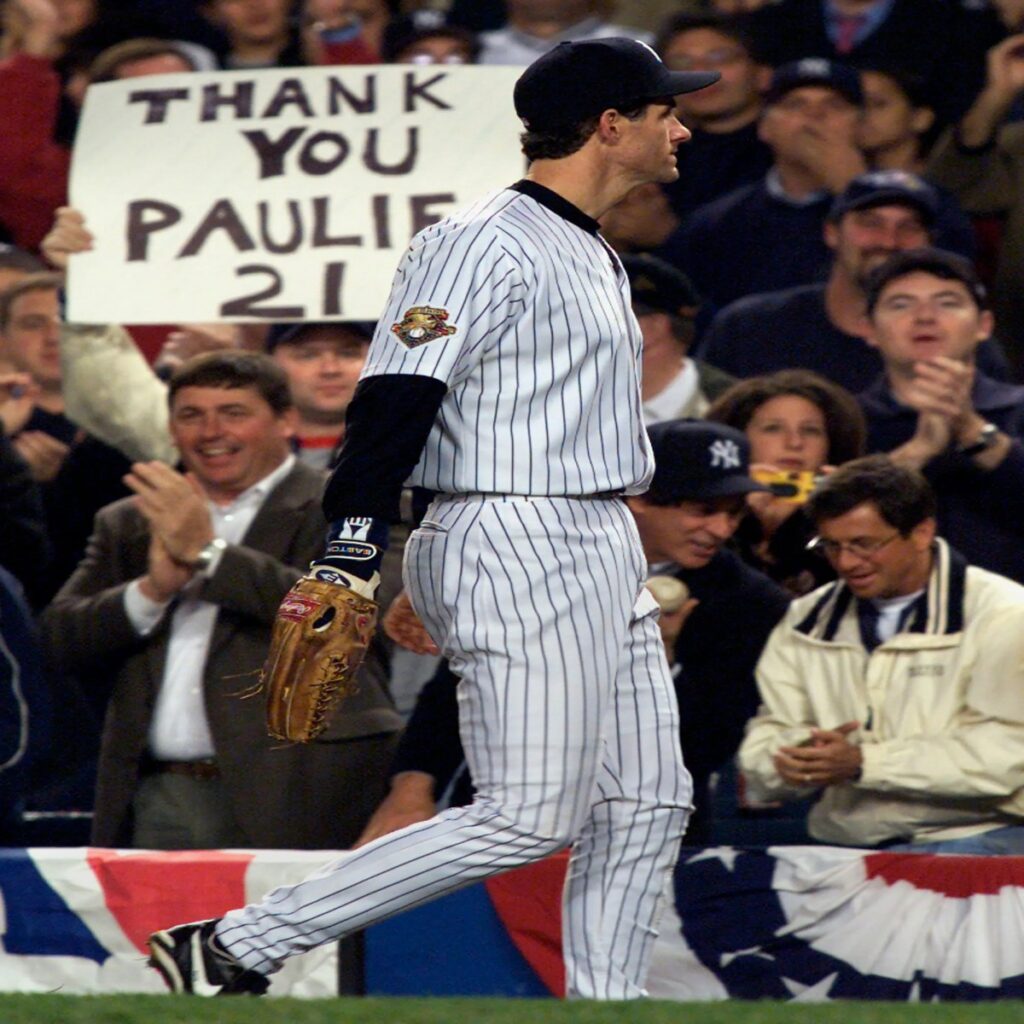
Paul O’Neill continued his minor league journey with the Cedar Rapids Reds in 1982, the Tampa Tarpons in 1983, and the Waterbury Reds in 1983, showcasing his talent and earning his place in the Reds organization. The 1984 season saw him with the Vermont Reds in the Eastern League, where he displayed a well-rounded performance with a .265 average, 31 doubles, 5 triples, 16 home runs, 76 RBIs, and 29 stolen bases.
On December 29, 1984, at the age of 21, Paul O’Neill married his childhood sweetheart, Nevalee Davis, in Columbus, Ohio.
In 1985, Paul O’Neill’s journey led him to the AAA Denver Zephyrs in Colorado, marking a breakthrough season. Across 137 games, he boasted a .305 average, leading the league in hits and doubles while contributing 7 home runs and 74 RBIs.
The MLB debut
After excelling in AAA, the Reds called up Paul O’Neill late in the 1985 season, marking his big league debut on September 3 against the Cardinals in St. Louis. Pinch-hitting for Dave Van Gorder in the top of the eighth inning, he singled to right, advancing the speedy Dave Concepcion to third, but a double play ended the inning. In four more September games, Paul O’Neill tallied four hits, one double, one RBI, and one run with a .333 average, .417 slugging, and a .750 OPS.
The 1986 season saw Paul O’Neill shuffle between the minors and majors, playing 55 games with Denver before a brief return to the Reds for three games where he went 0-2.
Paul O’Neill’s true introduction to the majors occurred in 1987, primarily serving as a pinch-hitter. In the first half, he played 36 games with 42 at-bats, hitting .143 with 2 home runs and 6 RBIs. Manager Pete Rose increased his playing time in the second half, resulting in a more comfortable performance. In 48 second-half games, he made 29 starts, hitting .297 with 12 doubles, 5 home runs, and 22 RBIs, boasting a .909 OPS.
By 1988, Paul O’Neill secured a full-time role in the majors. The Reds lineup featured former minor league teammates like Eric Davis, Kal Daniel, Chris Sabo, and Tom Browning, who pitched a perfect game on September 16, 1988. Paul O’Neill’s first full season concluded with 16 home runs, 73 RBIs, 8 stolen bases, and a .252 batting average.
In 1990, Paul O’Neill delivered another solid offensive season, batting .270 with 16 home runs and 78 RBIs. He also excelled in right field, leading all National League right fielders in fielding percentage (.993) and outfield assists (13). In the National League Championship Series, despite the Reds’ loss to the Pirates, Paul O’Neill showcased his hitting prowess with a .471 average, 3 doubles, one home run, and 4 RBIs. His 1.324 OPS led both teams, earning him recognition as the hitting star of the series.
In 1991, Paul O’Neill posted a .256 batting average but achieved the best power numbers of his career, with 28 home runs and 91 RBIs.

In the pinstripes
On November 3, 1992, the Reds orchestrated a significant trade, sending Paul O’Neill and minor leaguer Joe DeBerry to the New York Yankees in exchange for center fielder Roberto Kelly. The trade generated considerable excitement at the time, given Kelly’s status as the Yankees’ top young prospect, fresh from his first All-Star team appearance.
Initially devastated by leaving his hometown team, Paul O’Neill’s perspective shifted upon his arrival in New York. The Yankees welcomed him to a new world, introducing him to the likes of first baseman and captain Don Mattingly during spring training in 1993.
Paul O’Neill’s inaugural season with the Yankees in 1993 proved to be a success. Beyond his defensive prowess, he posted impressive offensive numbers, batting .311 with 20 home runs and 75 RBIs. The Yankees, as a team, performed well, winning 88 games and securing second place in the American League East, trailing the eventual world champion Toronto Blue Jays. Paul O’Neill’s intensity and production quickly endeared him to fans, making him a favorite and a team leader in New York. His batting average remained above .400 until June 17, and he earned a spot in the All-Star team in July.
The apex and bittersweet nature of Paul O’Neill’s professional career unfolded in 1994. Despite the truncated season, he excelled, leading the American League in hitting with a career-high .359 average. This marked the first batting title for a Yankee since Mattingly in 1985. Paul O’Neill also secured second place in On-Base Percentage (.461), and fourth in slugging (.603) and OPS (1.064). In roughly two-thirds of the season, he hit 21 home runs, collected 25 doubles, and amassed 83 RBIs, finishing fifth in MVP voting.
Capitalizing on his outstanding performance, Paul O’Neill signed a lucrative four-year contract with the Yankees worth $19 million. The 1995 season, delayed due to external factors, commenced on April 25, and Paul O’Neill started strong, hitting .346 with 11 home runs, 39 RBIs, and a 1.042 OPS in the first 52 games. Despite a downturn after the All-Star break, he delivered a standout game on August 31, smashing a career-high three home runs against the California Angels. By the season’s end, Paul O’Neill had a .300 batting average, 22 home runs, and 96 RBIs.
In the Yankees’ first postseason appearance in 14 years, facing the Seattle Mariners in 1995, Paul O’Neill showcased his spectacular hitting, batting .333 with 3 homers and 6 RBIs in the series.
The subsequent years continued Paul O’Neill’s impressive contributions to the Yankees, marked by strong seasons, pivotal moments in postseason games, and a significant role in the 1996 World Series victory against the Atlanta Braves. His performances in 1997 and 1998, including an exceptional ALCS in 1998, further solidified his reputation as a key player for the Yankees.
The 1999 season brought a solid batting average of .285, along with 39 doubles, 19 home runs, and 110 RBIs for Paul O’Neill. Despite suffering a rib injury in October, he played a crucial role in the World Series, helping the Yankees secure a victory in Game 1.
Even after briefly considering retirement, Paul O’Neill continued with the Yankees in 2000, maintaining a strong performance with a .283 batting average, 18 home runs, and 100 RBIs. In the World Series against the Mets, he emerged as the team’s savior, contributing crucial hits in various games, including a game-tying moment in the bottom of the ninth inning of Game 1 and key plays in subsequent victories. Paul O’Neill finished the series with a remarkable .474 average, featuring two doubles and two triples, showcasing his postseason prowess.

The retirement
As the 2001 season approached, Paul O’Neill faced uncertainty about his status. At 37 years old and with an expired contract, he grappled with the aftermath of a challenging late-season and postseason plagued by a lingering hip injury sustained in August. Contemplating retirement or the possibility of playing for a team closer to his hometown in Columbus, Paul O’Neill found himself at a crossroads.
However, on November 16, 2000, Paul O’Neill surprised many by signing a one-year contract worth $7.25 million. During the summer, he discreetly informed certain Yankees beat reporters of his decision to retire after the upcoming season. Still, he opted to withhold a formal announcement until the season’s conclusion, prioritizing his team’s focus over personal plans.
Amidst the uncertainties, Paul O’Neill faced another setback on September 7, suffering a stress fracture in his left foot that led to a stint on the disabled list. Remarkably, upon his return to the lineup on October 3, he made an impactful statement, going 2-4, hitting a two-run home run, and earning a spot on the playoff roster. Despite missing 25 games, 38-year-old Paul O’Neill delivered solid statistics, boasting a .267 average with 33 doubles, 21 home runs, and 70 RBIs. Notably, he stole 22 bases, establishing himself as the oldest player in history with at least 20 home runs and 20 steals in a single season. The Yankees secured their fourth consecutive division championship.
In Game 3 of the 2001 World Series, facing a 3-1 deficit in the ninth inning, Paul O’Neill played a pivotal role in the Yankees’ comeback, contributing alongside Tino Martinez before Derek Jeter‘s winning homer. Unfortunately, his illustrious career with the Yankees concluded with a Game 7 loss to the Diamondbacks in the World Series.
Following his retirement, Paul O’Neill returned to his Ohio roots, where he resides with his wife and three children. Since 2002, he has been actively involved as an in-game color commentator and analyst for the New York Yankees’ YES Network. Additionally, he maintains a web page at http://www.pauloneill21.com/ dedicated to selling memorabilia in support of his charitable endeavors.
The legacy
Over the course of his career, Paul O’Neill amassed a batting average of .288, showcasing his hitting prowess with 451 doubles, 21 triples, and 281 home runs. His offensive contributions extended to scoring 1,041 runs and collecting 1,269 RBIs. Paul O’Neill achieved a batting average over .300 six times and reached the milestone of at least 100 RBIs on four occasions. His accolades include one batting title, five All-Star game selections, and being part of six pennant-winning and five World Series champion teams. Throughout his extensive postseason experience, which spanned 85 games and 340 plate appearances, O’Neill maintained a postseason batting average of .284, accompanied by 11 home runs and 39 RBIs.
Fondly remembered by Yankee fans as the “heart and soul” of the team’s 1990s dynasty, Paul O’Neill earned the nickname “Warrior” from Yankee owner George Steinbrenner. This moniker reflected his unparalleled passion and love for the game. Following his retirement after the 2001 World Series, the significance of Paul O’Neill’s impact was evident as his number 21 jersey was worn only once, briefly by relief pitcher LaTroy Hawkins at the start of the 2008 season. Hawkins eventually switched to number 22 on April 16, 2008, responding to criticism from Yankee fans.
In recognition of his contributions, the Yankees paid tribute to Paul O’Neill by unveiling a plaque in Monument Park on August 9, 2014. The pinnacle of this honor came on August 21, 2022, when the Yankees officially retired O’Neill’s number 21 at Yankee Stadium. Notably, due to his decision not to get vaccinated against COVID-19, the retirement ceremony underwent adjustments to align with the team’s health protocols. Consequently, no current Yankees joined Paul O’Neill on the field, and he refrained from visiting any of the broadcast booths during the game.
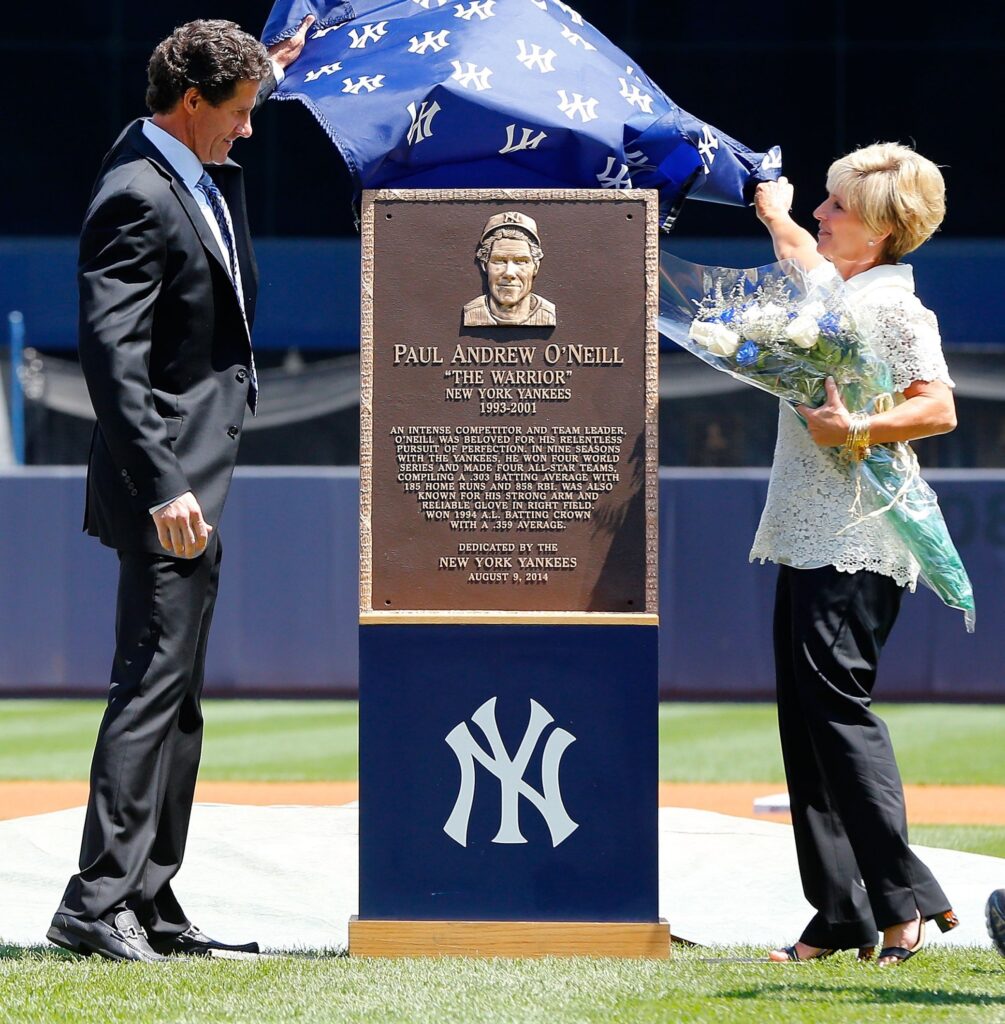
Paul O’Neill’s Greatest Moments
- 5-time All-Star (1991, 1994, 1995, 1997 & 1998)
- AL Batting Average Leader (1994)
- 20 Home Run Seasons: 7 (1991, 1993-1995, 1997, 1998 & 2001)
- 100 RBI Seasons: 4 (1997-2000)
- Won five World Series with the Cincinnati Reds (1990) and the New York Yankees (1996, 1998, 1999 & 2000)
Paul O’Neil FAQs
How old is Paul O’Neill?
60 years
When did Paul O’Neill retire?
2001
Why is Paul O’Neill not vaccinated?
He has refused to discuss his reasoning.
When is Paul O’Neill day at Yankee Stadium?
The Yankees honored O’Neill with a plaque in Monument Park on August 9, 2014. The Yankees retired O’Neill’s number 21 on August 21, 2022, at Yankee Stadium.
How tall is Paul O’Neill?
1.93 m
Where is Paul O’Neill?
He currently works on the network as the lead game analyst and color commentator.
What position did Paul O’Neill play?
Right Fielder
How much does Paul O’Neill make on yes?
Paul O’Neill earns an annual salary of $10,000 – $100,000
How long did Paul O’Neill play for the Yankees?
17 seasons
How much is Paul O’Neill worth?
Net worth of $20 million dollar
Who is replacing Paul O’Neill?
David Cone
How many ws does Paul O’Neill?
He was a five-time World Series champion
Where has Paul O’Neill been?
Live in Montgomery, Ohio
What is Paul O’Neill doing now?
Paul O’Neill back in the booth with his fellow broadcasters
How many rings does Paul O’Neill have?
5
What does Paul O’Neill do?
Baseball Player, Sports commentator
What is a Paul O’Neill baseball card worth?
Over $100
Where does Paul O’Neill live now?
Cincinnati, Columbus, Ohio
What number did Paul O’Neill wear?
21
Where did Paul O’Neill go to college?
Otterbein University
Who did the Yankees trade for Paul O’Neill?
Roberto Kelly
When did Paul O’Neill come to Yankees?
November 3, 1992
The met pitcher who served up a 31 pitch walk to Paul O’Neill in the 2000 world series?
Luis Polonia
When did Paul O’Neill play for the Yankees?
1993–2001
Who did the Yankees trade to get Paul O’Neill?
Roberto Kelly
Who is Paul O’Neill married to?
Nevalee
When was Paul O’Neill on the Cincinnati Reds team?
1985–1992
How many kids does Paul O’Neill have?
3
What teams did Paul O’Neill play for?
Cincinnati Reds (1985–1992) and New York Yankees (1993–2001)
Where does Paul O’Neill live during baseball season?
New York
Who is Paul O’Neill?
Paul Andrew O’Neill is an American former baseball right fielder who played 17 seasons in Major League Baseball.
Where did baseball player Paul O’Neill grew up?
Columbus, Ohio
The stats
| SUMMARY | WAR | AB | H | HR | BA | R | RBI | SB | OBP | SLG | OPS | OPS+ |
| Career | 38.8 | 7318 | 2105 | 281 | .288 | 1041 | 1269 | 141 | .363 | .470 | .833 | 120 |
Paul O’Neill’s standard batting record
| Year | G | PA | AB | R | H | 2B | 3B | HR | RBI | SB | CS | BB | SO | BA | OBP | SLG | OPS | OPS+ | TB | GDP | HBP | SH | SF | IBB | Pos |
| 1985 | 5 | 12 | 12 | 1 | 4 | 1 | 0 | 0 | 1 | 0 | 0 | 0 | 2 | 0.333 | 0.333 | 0.417 | 0.75 | 106 | 5 | 0 | 0 | 0 | 0 | 0 | /H7 |
| 1986 | 3 | 3 | 2 | 0 | 0 | 0 | 0 | 0 | 0 | 0 | 0 | 1 | 1 | 0 | 0.333 | 0 | 0.333 | -1 | 0 | 0 | 0 | 0 | 0 | 0 | /H |
| 1987 | 84 | 178 | 160 | 24 | 41 | 14 | 1 | 7 | 28 | 2 | 1 | 18 | 29 | 0.256 | 0.331 | 0.488 | 0.819 | 111 | 78 | 3 | 0 | 0 | 0 | 1 | H978/31 |
| 1988 | 145 | 533 | 485 | 58 | 122 | 25 | 3 | 16 | 73 | 8 | 6 | 38 | 65 | 0.252 | 0.306 | 0.414 | 0.72 | 102 | 201 | 7 | 2 | 3 | 5 | 5 | *93H/8 |
| 1989 | 117 | 480 | 428 | 49 | 118 | 24 | 2 | 15 | 74 | 20 | 5 | 46 | 64 | 0.276 | 0.346 | 0.446 | 0.792 | 122 | 191 | 7 | 2 | 0 | 4 | 8 | *9/8H |
| 1990 | 145 | 564 | 503 | 59 | 136 | 28 | 0 | 16 | 78 | 13 | 11 | 53 | 103 | 0.27 | 0.339 | 0.421 | 0.761 | 105 | 212 | 12 | 2 | 1 | 5 | 13 | *9H/8 |
| 1991 | 152 | 607 | 532 | 71 | 136 | 36 | 0 | 28 | 91 | 12 | 7 | 73 | 107 | 0.256 | 0.346 | 0.481 | 0.827 | 127 | 256 | 8 | 1 | 0 | 1 | 14 | *9/H |
| 1992 | 148 | 584 | 496 | 59 | 122 | 19 | 1 | 14 | 66 | 6 | 3 | 77 | 85 | 0.246 | 0.346 | 0.373 | 0.719 | 101 | 185 | 10 | 2 | 3 | 6 | 15 | *9H |
| 1993 | 141 | 547 | 498 | 71 | 155 | 34 | 1 | 20 | 75 | 2 | 4 | 44 | 69 | 0.311 | 0.367 | 0.504 | 0.871 | 136 | 251 | 13 | 2 | 0 | 3 | 5 | *97H/D |
| 1994 | 103 | 443 | 368 | 68 | 132 | 25 | 1 | 21 | 83 | 5 | 4 | 72 | 56 | 0.359 | 0.46 | 0.603 | 1.064 | 177 | 222 | 16 | 0 | 0 | 3 | 13 | *97H/D |
| 1995 | 127 | 543 | 460 | 82 | 138 | 30 | 4 | 22 | 96 | 1 | 2 | 71 | 76 | 0.3 | 0.387 | 0.526 | 0.913 | 137 | 242 | 25 | 1 | 0 | 11 | 8 | *97/HD |
| 1996 | 150 | 660 | 546 | 89 | 165 | 35 | 1 | 19 | 91 | 0 | 1 | 102 | 76 | 0.302 | 0.411 | 0.474 | 0.885 | 123 | 259 | 21 | 4 | 0 | 8 | 8 | *9/DH3 |
| 1997 | 149 | 637 | 553 | 89 | 179 | 42 | 0 | 21 | 117 | 10 | 7 | 75 | 92 | 0.324 | 0.399 | 0.514 | 0.912 | 137 | 284 | 16 | 0 | 0 | 9 | 8 | *9/H3D |
| 1998 | 152 | 672 | 602 | 95 | 191 | 40 | 2 | 24 | 116 | 15 | 1 | 57 | 103 | 0.317 | 0.372 | 0.51 | 0.882 | 130 | 307 | 22 | 2 | 0 | 11 | 2 | *9/HD |
| 1999 | 153 | 675 | 597 | 70 | 170 | 39 | 4 | 19 | 110 | 11 | 9 | 66 | 89 | 0.285 | 0.353 | 0.459 | 0.812 | 107 | 274 | 24 | 2 | 0 | 10 | 1 | *9/H |
| 2000 | 142 | 628 | 566 | 79 | 160 | 26 | 0 | 18 | 100 | 14 | 9 | 51 | 90 | 0.283 | 0.336 | 0.424 | 0.76 | 92 | 240 | 17 | 0 | 0 | 11 | 2 | *9/DH |
| 2001 | 137 | 563 | 510 | 77 | 136 | 33 | 1 | 21 | 70 | 22 | 3 | 48 | 59 | 0.267 | 0.33 | 0.459 | 0.789 | 105 | 234 | 20 | 2 | 0 | 3 | 4 | *9/DH |
| 17 Yrs | 2053 | 8329 | 7318 | 1041 | 2105 | 451 | 21 | 281 | 1269 | 141 | 73 | 892 | 1166 | 0.288 | 0.363 | 0.47 | 0.833 | 120 | 3441 | 221 | 22 | 7 | 90 | 107 | |
| 162 Game Avg. | 162 | 657 | 577 | 82 | 166 | 36 | 2 | 22 | 100 | 11 | 6 | 70 | 92 | 0.288 | 0.363 | 0.47 | 0.833 | 120 | 272 | 17 | 2 | 1 | 7 | 8 | |
| G | PA | AB | R | H | 2B | 3B | HR | RBI | SB | CS | BB | SO | BA | OBP | SLG | OPS | OPS+ | TB | GDP | HBP | SH | SF | IBB | Pos | |
| NYY (9 yrs) | 1254 | 5368 | 4700 | 720 | 1426 | 304 | 14 | 185 | 858 | 80 | 40 | 586 | 710 | 0.303 | 0.377 | 0.492 | 0.869 | 125 | 2313 | 174 | 13 | 0 | 69 | 51 | |
| CIN (8 yrs) | 799 | 2961 | 2618 | 321 | 679 | 147 | 7 | 96 | 411 | 61 | 33 | 306 | 456 | 0.259 | 0.336 | 0.431 | 0.767 | 111 | 1128 | 47 | 9 | 7 | 21 | 56 | |
| AL (9 yrs) | 1254 | 5368 | 4700 | 720 | 1426 | 304 | 14 | 185 | 858 | 80 | 40 | 586 | 710 | 0.303 | 0.377 | 0.492 | 0.869 | 125 | 2313 | 174 | 13 | 0 | 69 | 51 | |
| NL (8 yrs) | 799 | 2961 | 2618 | 321 | 679 | 147 | 7 | 96 | 411 | 61 | 33 | 306 | 456 | 0.259 | 0.336 | 0.431 | 0.767 | 111 | 1128 | 47 | 9 | 7 | 21 | 56 |
Paul O’Neill’s postseason batting
| Year | G | PA | AB | R | H | 2B | 3B | HR | RBI | SB | CS | BB | SO | BA | OBP | SLG | OPS | TB | GDP | HBP | SH | SF | IBB | WPA | cWPA |
| 1990 | 5 | 18 | 17 | 1 | 8 | 3 | 0 | 1 | 4 | 1 | 0 | 1 | 1 | 0.471 | 0.5 | 0.824 | 1.324 | 14 | 0 | 0 | 0 | 0 | 0 | 0.41 | 5.90% |
| 1990 | 4 | 18 | 12 | 2 | 1 | 0 | 0 | 0 | 1 | 1 | 0 | 5 | 2 | 0.083 | 0.353 | 0.083 | 0.436 | 1 | 0 | 0 | 1 | 0 | 0 | -0.07 | -3.60% |
| 1995 | 5 | 24 | 18 | 5 | 6 | 0 | 0 | 3 | 6 | 0 | 0 | 5 | 5 | 0.333 | 0.458 | 0.833 | 1.292 | 15 | 0 | 0 | 0 | 1 | 0 | 0.13 | 3.10% |
| 1996 | 4 | 15 | 15 | 0 | 2 | 0 | 0 | 0 | 0 | 0 | 0 | 0 | 2 | 0.133 | 0.133 | 0.133 | 0.267 | 2 | 2 | 0 | 0 | 0 | 0 | -0.52 | -5.50% |
| 1996 | 4 | 14 | 11 | 1 | 3 | 0 | 0 | 1 | 2 | 0 | 0 | 3 | 2 | 0.273 | 0.429 | 0.545 | 0.974 | 6 | 1 | 0 | 0 | 0 | 0 | 0.08 | 2.00% |
| 1996 | 5 | 15 | 12 | 1 | 2 | 2 | 0 | 0 | 0 | 0 | 0 | 3 | 2 | 0.167 | 0.333 | 0.333 | 0.667 | 4 | 1 | 0 | 0 | 0 | 0 | -0.07 | -2.90% |
| 1997 | 5 | 22 | 19 | 5 | 8 | 2 | 0 | 2 | 7 | 0 | 0 | 3 | 0 | 0.421 | 0.5 | 0.842 | 1.342 | 16 | 0 | 0 | 0 | 0 | 0 | 0.46 | 5.70% |
| 1998 | 3 | 12 | 11 | 1 | 4 | 2 | 0 | 1 | 1 | 0 | 0 | 1 | 1 | 0.364 | 0.417 | 0.818 | 1.235 | 9 | 0 | 0 | 0 | 0 | 0 | 0.08 | 0.50% |
| 1998 | 6 | 28 | 25 | 6 | 7 | 2 | 0 | 1 | 3 | 2 | 0 | 3 | 4 | 0.28 | 0.357 | 0.48 | 0.837 | 12 | 0 | 0 | 0 | 0 | 0 | 0.31 | 6.30% |
| 1998 | 4 | 20 | 19 | 3 | 4 | 1 | 0 | 0 | 0 | 0 | 0 | 1 | 2 | 0.211 | 0.25 | 0.263 | 0.513 | 5 | 1 | 0 | 0 | 0 | 0 | 0.13 | 1.10% |
| 1999 | 2 | 9 | 8 | 2 | 2 | 0 | 0 | 0 | 0 | 0 | 0 | 1 | 1 | 0.25 | 0.333 | 0.25 | 0.583 | 2 | 0 | 0 | 0 | 0 | 0 | 0.01 | 0.00% |
| 1999 | 5 | 22 | 21 | 2 | 6 | 0 | 0 | 0 | 1 | 0 | 0 | 1 | 5 | 0.286 | 0.318 | 0.286 | 0.604 | 6 | 0 | 0 | 0 | 0 | 0 | 0.06 | 1.40% |
| 1999 | 4 | 17 | 15 | 0 | 3 | 0 | 0 | 0 | 4 | 0 | 0 | 2 | 2 | 0.2 | 0.294 | 0.2 | 0.494 | 3 | 1 | 0 | 0 | 0 | 0 | -0.08 | 0.50% |
| 2000 | 5 | 21 | 19 | 4 | 4 | 1 | 0 | 0 | 0 | 0 | 0 | 2 | 4 | 0.211 | 0.286 | 0.263 | 0.549 | 5 | 2 | 0 | 0 | 0 | 1 | -0.25 | -1.80% |
| 2000 | 6 | 22 | 20 | 0 | 5 | 0 | 0 | 0 | 5 | 0 | 0 | 1 | 2 | 0.25 | 0.273 | 0.25 | 0.523 | 5 | 0 | 0 | 0 | 1 | 0 | -0.05 | 0.00% |
| 2000 | 5 | 22 | 19 | 2 | 9 | 2 | 2 | 0 | 2 | 0 | 0 | 3 | 4 | 0.474 | 0.545 | 0.789 | 1.335 | 15 | 2 | 0 | 0 | 0 | 1 | -0.13 | -3.90% |
| 2001 | 3 | 11 | 11 | 1 | 1 | 1 | 0 | 0 | 0 | 0 | 0 | 0 | 0 | 0.091 | 0.091 | 0.182 | 0.273 | 2 | 0 | 0 | 0 | 0 | 0 | -0.17 | -0.90% |
| 2001 | 5 | 13 | 12 | 2 | 5 | 0 | 0 | 2 | 3 | 0 | 0 | 1 | 0 | 0.417 | 0.462 | 0.917 | 1.378 | 11 | 0 | 0 | 0 | 0 | 0 | 0 | 0.20% |
| 2001 | 5 | 17 | 15 | 1 | 5 | 1 | 0 | 0 | 0 | 1 | 0 | 2 | 2 | 0.333 | 0.412 | 0.4 | 0.812 | 6 | 2 | 0 | 0 | 0 | 0 | -0.16 | -3.10% |
| 8 Yrs (19 Series) | 2 | 11 | 39 | 5 | 0 | 38 | 41 | 0.284 | 0.363 | 0.465 | 0.828 | 139 | 12 | 0 | 1 | 2 | 2 | 0.16 | 4.90% | ||||||
| G | PA | AB | R | H | 2B | 3B | HR | RBI | SB | CS | BB | SO | BA | OBP | SLG | OPS | TB | GDP | HBP | SH | SF | IBB | WPA | cWPA | |
| 7 ALDS | 27 | 114 | 101 | 18 | 27 | 6 | 0 | 6 | 14 | 0 | 0 | 12 | 13 | 0.267 | 0.342 | 0.505 | 0.847 | 51 | 4 | 0 | 0 | 1 | 1 | -0.27 | 1.00% |
| 5 ALCS | 26 | 99 | 89 | 11 | 26 | 2 | 0 | 4 | 14 | 2 | 0 | 9 | 13 | 0.292 | 0.354 | 0.449 | 0.803 | 40 | 1 | 0 | 0 | 1 | 0 | 0.4 | 9.90% |
| 1 NLCS | 5 | 18 | 17 | 1 | 8 | 3 | 0 | 1 | 4 | 1 | 0 | 1 | 1 | 0.471 | 0.5 | 0.824 | 1.324 | 14 | 0 | 0 | 0 | 0 | 0 | 0.41 | 5.90% |
| 6 WS | 27 | 109 | 92 | 9 | 24 | 6 | 2 | 0 | 7 | 2 | 0 | 16 | 14 | 0.261 | 0.37 | 0.37 | 0.74 | 34 | 7 | 0 | 1 | 0 | 1 | -0.37 | -11.90% |
Paul O’Neill’s career graph
| Hall of Fame | All-Star Games | Awards | MVP (rank, share) |
| 2007 BBWAA ( 2.2%) | 1991 * 1994 * 1995 * 1997 (RF) 1998 * | 1994 AL Batting Title | 1990 NL (19, 2%) 1994 AL (5, 38%) 1995 AL (15, 4%) 1997 AL (12, 9%) 1998 AL (12, 9%) 0.62 Career Shares (416th) |
| Weekly Awards | Home Run Derby | WAR Position Players | Offensive WAR |
| 2001 Jul 29th AL Player of the Week | 1991 | 1994 AL 4.3 (7th) 1998 AL 5.8 (10th) | 1994 AL 4.9 (5th) |
| Defensive WAR | Batting Average | On-Base% | Slugging % |
| 1991 NL 1.6 (7th) | 1993 AL .311 (9th) 1994 AL .359 (1st) 1997 AL .324 (6th) | 1994 AL .460 (2nd) 1996 AL .411 (10th) 1997 AL .399 (9th) | 1994 AL .603 (4th) |
| On-Base Plus Slugging | Hits | Doubles | Home Runs |
| 1994 AL 1.064 (4th) | 1997 AL 179 (9th) 1998 AL 191 (7th) Career 2,105 (233rd) | 1991 NL 36 (3rd) 1997 AL 42 (5th) 1999 AL 39 (9th) Career 451 (107th) | 1991 NL 28 (7th) Career 281 (192nd) |
| Runs Batted In | Bases on Balls | Adjusted OPS+ | Runs Created |
| 1997 AL 117 (6th) 1998 AL 116 (10th) Career 1,269 (131st) | 1992 NL 77 (9th) 1994 AL 72 (4th) 1996 AL 102 (6th) Career 892 (187th) | 1994 AL 177 (3rd) | 1994 AL 100 (6th) Career 1,241 (189th) |
| Adj. Batting Runs | Adj. Batting Wins | Extra Base Hits | Times On Base |
| 1994 AL 47 (3rd) Career 231 (236th) | 1994 AL 4.2 (3rd) | 1991 NL 64 (5th) Career 753 (159th) | 1994 AL 204 (7th) Career 3,019 (203rd) |
| Offensive Win % | Sacrifice Flies | Intentional Bases on Balls | Double Plays Grounded Into |
| 1994 AL .770 (3rd) | 1995 AL 11 (2nd) 1998 AL 11 (3rd) 1999 AL 10 (3rd) 2000 AL 11 (4th) Career 90 (66th) | 1991 NL 14 (5th) 1992 NL 15 (5th) 1994 AL 13 (4th) Career 107 (128th) | 1994 AL 16 (5th) 1995 AL 25 (1st) 1996 AL 21 (4th) 1998 AL 22 (1st) 1999 AL 24 (3rd) 2001 AL 20 (2nd) Career 221 (71st) |
| Caught Stealing | SB % | Power-Speed # | AB per SO |
| 2000 AL 9 (8th) | 1998 AL 93.75 (1st) 2001 AL 88.00 (3rd) | 1989 NL 17.1 (9th) 1991 NL 16.8 (9th) Career 187.8 (123rd) | 2001 AL 8.6 (7th) |
| AB per HR | Outs Made | Base-Out Runs Added (RE24) | Win Probability Added (WPA) |
| 1991 NL 19.0 (8th) | 1999 AL 470 (6th) Career 5,604 (228th) | 1994 AL 43.25 (4th) 1997 AL 44.79 (6th) Career 255.09 (224th) | 1994 AL 3.9 (3rd) 1997 AL 4.1 (6th) Career 22.0 (227th) |
| Situ. Wins Added (WPA/LI) | Championship WPA (cWPA) | Base-Out Wins Added (REW) | Total Zone Runs |
| 1994 AL 3.5 (4th) | 1993 AL 4.0 (9th) 1994 AL 2.8 (3rd) 1997 AL 2.6 (6th) | 1994 AL 4.0 (3rd) 1997 AL 4.1 (6th) Career 24.1 (232nd) | 1991 NL 20 (2nd) |
| Def. Games as RF (s.1901) | Putouts as RF (s.1901) | Assists as RF (s.1901) | Errors Committed as RF (s.1901) |
| 1990 NL 141 (5th) 1991 NL 150 (2nd) 1992 NL 143 (1st) 1996 AL 146 (3rd) 1997 AL 146 (3rd) 1998 AL 150 (2nd) 1999 AL 151 (5th) 2000 AL 140 (3rd) 2001 AL 130 (5th) Career 1,848 (15th) | 1990 NL 273 (4th) 1991 NL 302 (1st) 1992 NL 291 (2nd) 1994 AL 190 (5th) 1995 AL 190 (4th) 1996 AL 295 (2nd) 1997 AL 291 (3rd) 1998 AL 295 (1st) 1999 AL 291 (4th) 2000 AL 293 (1st) Career 3,544 (16th) | 1989 NL 7 (4th) 1990 NL 13 (1st) 1991 NL 13 (2nd) 1992 NL 12 (2nd) 1997 AL 7 (5th) 1998 AL 11 (3rd) 1999 AL 10 (5th) Career 105 (49th) | 1997 AL 5 (5th) 1999 AL 8 (1st) |
| Double Plays Turned as RF (s.1901) | Def. Games as OF | Assists as OF | Errors Committed as OF |
| 1989 NL 1 (4th) 1991 NL 2 (1st) 1992 NL 2 (3rd) 1996 AL 3 (2nd) 1998 AL 6 (1st) 1999 AL 3 (3rd) 2000 AL 3 (4th) Career 20 (82nd) | 1991 NL 150 (4th) Career 1,932 (59th) | 1991 NL 13 (3rd) 1992 NL 12 (3rd) | 1999 AL 8 (5th) |
| Double Plays Turned as OF | Total Zone Runs as RF (s.1953) | Range Factor/9Inn as RF (s.1948) | Range Factor/Game as RF (s.1901) |
| 1991 NL 2 (3rd) 1996 AL 3 (5th) 1998 AL 6 (1st) 1999 AL 3 (5th) | 1988 NL 7 (2nd) 1991 NL 20 (2nd) 1992 NL 5 (5th) 1998 AL 11 (2nd) 2000 AL 7 (2nd) | 1988 NL 2.14 (3rd) 1991 NL 2.25 (3rd) 1992 NL 2.25 (3rd) 1996 AL 2.19 (5th) 1997 AL 2.12 (5th) 1998 AL 2.12 (5th) 2000 AL 2.33 (3rd) Career 2.13 (52nd) | 1988 NL 1.96 (4th) 1989 NL 1.92 (4th) 1991 NL 2.10 (3rd) 1992 NL 2.12 (4th) 1994 AL 2.18 (5th) 1996 AL 2.07 (3rd) 1997 AL 2.04 (3rd) 2000 AL 2.13 (4th) Career 1.97 (61st) |
| Fielding % as RF (s.1901) | Total Zone Runs as OF (s.1953) | Fielding % as OF | |
| 1988 NL .982 (4th) 1989 NL .982 (2nd) 1990 NL .993 (1st) 1991 NL .994 (1st) 1992 NL .997 (1st) 1994 AL .995 (1st) 1995 AL .985 (3rd) 1996 AL 1.000 (1st) 1997 AL .983 (2nd) 1998 AL .987 (3rd) 2000 AL .993 (1st) 2001 AL .981 (5th) Career .988 (22nd) | 1988 NL 9 (3rd) 1991 NL 20 (2nd) | 1990 NL .993 (2nd) 1991 NL .994 (3rd) 1992 NL .997 (1st) 1994 AL .995 (4th) 1996 AL 1.000 (1st) 2000 AL .993 (5th) |
Source: Baseball-Reference
- Categories: David Cone, david wells, derek jeter, don mattingly, George Steinbrenner, paul o'neill
- Tags: David Cone, david wells, derek jeter, don mattingly, George Steinbrenner, paul o'neill
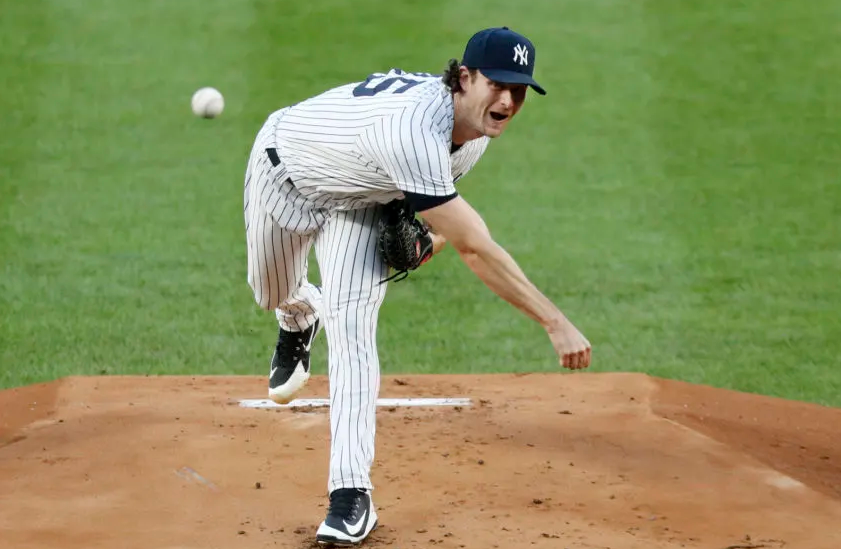

 Follow Us
Follow Us